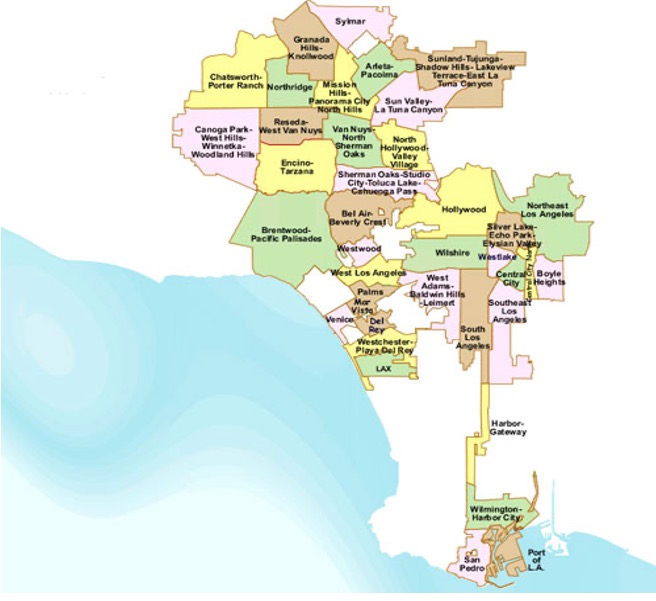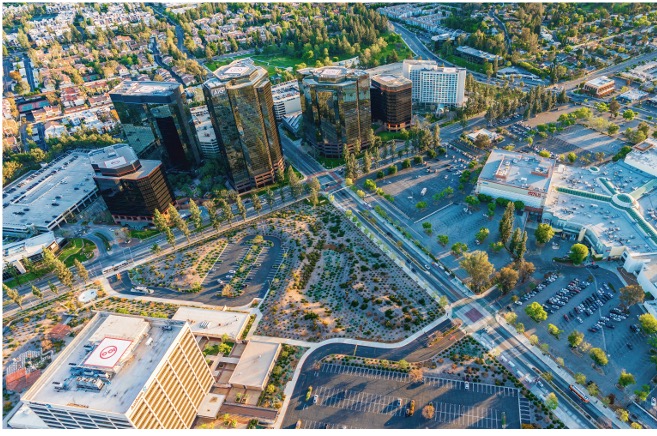Comments
PLANNING WATCH LA - State law and the City’s charter requires LA to have a General Plan. It contains a Land Use element (chapter) divided into 35 Community Plans, shown above. Professional city planning practice calls for updates of citywide General Plan’s elements every ten years and Community Plans every six years, per a City Council's mandate.

So much for these official requirements, though, because nearly every General Plan element is out-of-date. For example, LA’s Infrastructure Element is 51 years old and only addresses historical monuments. The Public Facilities and Services Element is 54 years old and restricts itself to garbage collection.
The Community Plans should apply the General Plan’s existing mandatory elements (Transportation/Mobility, Housing, Safety, Open Space, Conservation, and Noise) and voluntary elements (General Plan Framework, Infrastructure, Public Facilities, Air Quality, and Health) to local communities. Nevertheless, City Hall misuses the Community Plan update process to adopt local up-zoning ordinances that only implement LA’s 2021-2029 Housing Element. Dubbed re-zoning, these ordinances would expand the list of permitted uses and slash regulations for building size and required parking. Such changes increase the market value of mostly commercial parcels and, therefore, generate windfall profits for flippers. As for non-flippers, up-zoning creates new opportunities for them to build large, lucrative, instantly legal buildings. What a deal!
The intended use of Updated Community Plans, to apply new data and adopted planning policies to local communities, has been usurped by re-zoning ordinances that gut land use laws for the benefit of real estate speculators. In a misleading Los Angeles Times editorial bemoaning stalled Community Plan Updates for Hollywood and Downtown LA, this bogged-down legislation is considered essential for tackling LA’s homeless crisis:
“Council members treat their districts like fiefdoms in which they have complete control over land use decisions. But that deference is now slowing the city’s much needed effort to modernize its land use rules . . . As the months ticked by, civic leaders have become increasingly concerned by the delays. The Downtown Community Plan . . . sets the vision for the next 20 years of development and is an integral piece of the city’s strategy to solve the housing crisis.”
Like other members of LA’s urban growth machine, the city’s newspaper-of-record doesn’t know much about planning, zoning, and housing, but it rarely errors in calls for policies that benefit real estate developers – always hiding behind the myth that new market rate and luxury apartments reduce homelessness.
No, your eyes aren’t lying. Expensive apartments make the housing crisis worse. This is why the Los Angeles Times, like the Urban Growth Machine’s other members, display so much willful ignorance about the housing crisis. As a result, homelessness steadily worsens, despite Mayor Karen Bass’s well-intentioned Inside Safe temporary housing program.

Some examples of this continued duplicity particularly stand out:
Despite endless repetition, LA’s housing shortage only applies to low-priced units, not the market-rate housing that developers choose to build when local zoning requirements are eased This is confirmed by the Vacancy Report: How Los Angeles Leaves Homes Empty and People Unhoused.
- This study demonstrates that Los Angeles had 90,000 vacant units in 2020, before 200,000 Angelinos left for cheaper housing markets. Unfortunately, most of these empty units are expensive, far beyond the financial reach of impoverished people sleeping in tents, cars, and cold sidewalks and alleys.
- The LAT’s solution to homelessness: deregulating land-use rules through Community Plan zoning ordinances, so developers will build low-priced infill housing, is a ruse. Developers have no interest in building inexpensive housing. If they did, then LA’s long commercial corridors would sprout new, private sector low-rent housing everywhere since their zoning already allows R-3 and R-4 apartments.
- The need for low-priced housing, at least 500,000 units in Los Angeles County, cannot be met by Sacramento’s housing schemes, including Senate Bill 9, City Hall’s density bonus ordinances, and LA’s voter-approved Measure ULA, the 5% Real Estate Transfer Tax. In LA over half the population is severely rent burdened because their incomes have been stagnant for several decades, while the inflation-controlled cost of housing has more than doubled, propelled by corporate investment in residential real estate. Even if the Urban Growth Machine’s deceptive messaging about solving the housing crisis by handouts to real estate speculators were true, it would not be enough. Homelessness would still rise, and elected officials would yield to their frustrated constituents by ordering more LAPD homeless sweeps.
- Between 2015 to 2022, City Planning’s Housing Progress Dashboard reports that LA approved 27,397 affordable units. How many of these units were actually built and rented to verified low-income tenants remains a mystery. What we do know, however, is that in October 2022, the Los Angeles Housing Authority opened up the window for 30,000 Section 8 low-income housing vouchers. They received 223,375 applications, which meant only 13 percent of applicants received a voucher. In the past, about half of those obtaining a Section 8 voucher found a landlord who would rent to them. Needless to say, the gap between those who need low-priced housing and those who don’t find it is staggering, at least a half-million people.
What can be done? Your advocacy for the following could make a difference:
- Expanding Federal Section 8 vouchers.
- Strengthening legislation to bar landlords from rejecting Section 8 applicants.
- Throttling down the speculative purchase of houses, condos, and apartment buildings since it drives up the cost of housing.
- Increasing wage levels so more families can afford to rent an apartment or buy a house.
- Restoring HUD and CRA public housing programs.
- Reducing evictions of existing low-income tenants.
- Extending LA’s eviction moratorium past January 31, 2023.
(Dick Platkin is a retired Los Angeles city planner who reports on local planning issues for CityWatchLA. He serves on the board of United Neighborhoods for Los Angeles (UN4LA). Previous Planning Watch columns are available at the CityWatchLA archives. Please send questions and corrections to [email protected].)















